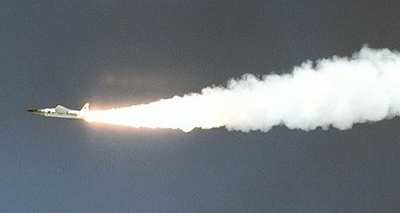Wed, Sep 29, 2004
Next Step: Mach 10 Free Flight
 NASA aeronautics researchers are
looking forward to flying the X-43A research aircraft at speeds up
to 10 times the speed of sound later this fall, following a
successful "captive carry" dress rehearsal flight from NASA's
Dryden Flight Research Center Sept. 27.
NASA aeronautics researchers are
looking forward to flying the X-43A research aircraft at speeds up
to 10 times the speed of sound later this fall, following a
successful "captive carry" dress rehearsal flight from NASA's
Dryden Flight Research Center Sept. 27.
According to X-43A lead operations engineer David McAllister,
who served as test director for the mission, the captive carry
flight duplicated all operational functions of the planned
7,000-mph - or Mach 10 - flight and served as a training exercise
for staff, except that the X-43A and its modified Pegasus booster
were not released from NASA's B-52B launch aircraft and their
engines were not ignited.
"We have two primary purposes for doing a captive carry flight,"
said McAllister. "The first is to make sure that the X-43 and its
booster rocket - two highly complex systems - are ready for flight.
The second is to make sure we're well trained. It's a very big
operation (and) we want to make sure that all those people and all
those systems are ready to go."

The X-43A is powered by a revolutionary air-breathing
supersonic-combustion ramjet - or "scramjet" - engine. Scramjet
engines could enable future hypersonic aircraft or space-access
vehicles to either carry a greater payload or be smaller and
lighter, since they would not have to carry large oxidizer tanks as
present-day launch rockets do. If successful, the Mach 10 flight
will break all speed records for an aircraft powered by an
air-breathing engine.
After a review of captive-carry flight data, project engineers
are expected to set a tentative date for the final X-43A flight for
early November.

The X-43A project is part of the Hyper-X hypersonic research
program led by NASA's Aeronautics Research Mission Directorate and
operated jointly by NASA's Langley Research Center, Hampton (VA),
and Dryden Flight Research Center, Edwards (CA). The program aims
to demonstrate air-breathing engine technologies that promise to
increase payload capacity - or reduce vehicle size for the same
payload - for future hypersonic aircraft and reusable space launch
vehicles.
More News
Aero Linx: Model Aeronautical Association of Australia MAAA clubs are about fun flying, camaraderie and community. For over 75 years, the MAAA has been Australia’s largest fl>[...]
Touchdown Zone Lighting Two rows of transverse light bars located symmetrically about the runway centerline normally at 100 foot intervals. The basic system extends 3,000 feet alon>[...]
“Discovery and innovation are central to our mission at Virgin Galactic. We’re excited to build on our successful record of facilitating scientific experiments in subor>[...]
How To Get A Story On Aero-TV News/Feature Programming How do I submit a story idea or lead to Aero-TV? If you would like to submit a story idea or lead, please contact Jim Campbel>[...]
Student Pilot Reported That During Rotation, “All Of A Sudden The Back Of The Plane Kicked To The Right..." Analysis: The student pilot reported that during rotation, “>[...]
 ANN's Daily Aero-Linx (05.02.24)
ANN's Daily Aero-Linx (05.02.24) ANN's Daily Aero-Term (05.02.24): Touchdown Zone Lighting
ANN's Daily Aero-Term (05.02.24): Touchdown Zone Lighting Aero-News: Quote of the Day (05.02.24)
Aero-News: Quote of the Day (05.02.24) ANN FAQ: Contributing To Aero-TV
ANN FAQ: Contributing To Aero-TV NTSB Final Report: Cirrus Design Corp SR20
NTSB Final Report: Cirrus Design Corp SR20





